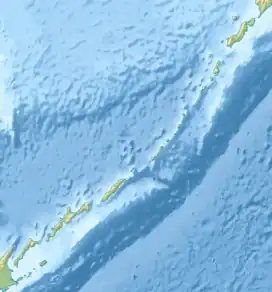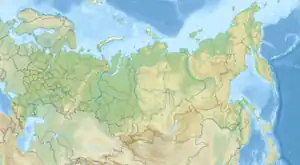1958 Kuril Islands earthquake
The 1958 Kuril Islands earthquake or Etorofu earthquake was a Mw 8.3–8.4 earthquake that struck near the Kuril island of Iturup on November 6, 1958, at 22:58 UTC, or 09:58 on the 7th local time. The earthquake occurred as the result of shallow reverse faulting along the Kuril-Kamchatka Trench, and caused Modified Mercalli Intensity (MMI) X (Extreme) shaking, as well as a tsunami 5 m (16 ft) high. Iturup sustained significant damage as a result of the shaking and tsunami, with other locations along the Kuril Islands also reporting strong damage.
 Moscow Kurilsk  Moscow Kurilsk | |
| UTC time | 1958-11-06 22:58:09 |
|---|---|
| ISC event | 885402 |
| USGS-ANSS | ComCat |
| Local date | November 7, 1958 |
| Local time | 09:58:09 |
| Magnitude | Mw 8.3–8.4, Ms 7.9–8.5[lower-roman 1] |
| Depth | 35–40 km (22–25 mi) |
| Epicenter | 44.479°N 148.45°E |
| Areas affected | Soviet Union |
| Max. intensity | X (Extreme) |
| Tsunami | 5 m (16 ft) |
Tectonic setting
The Kuril islands lie along the seismically active convergent boundary between the Pacific Plate and the Okhotsk Plate (a microplate within the North American Plate).[7] The trench that accommodates this subduction—the Kuril-Kamchatka Trench, accommodates the convergence at a rate of 80 mm (3.1 in)/yr, with rates increasing from north to south.[7] This active subduction zone spawns many large Kamchatka earthquakes with strong earthquakes along the trench occurring in 1737, 1841, February 1923, April 1923, 1952, 1959, and in 1963.
Earthquake
The earthquake struck at 09:58 on November 7 locally, or 22:58 on the 6th in UTC. The earthquake occurred at a depth of 35–40 km (22–25 mi), with a moment magnitude of Mw 8.3–8.4.[1] The International Seismological Centre estimated the surface wave magnitude for this event at Ms 8.2 ± 0.3.[2] Maximum felt intensities associated with the earthquake were X (Extreme) on the Modified Mercalli intensity scale in Lake Iturup.[8] The earthquake occurred as the result of reverse faulting along the Kuril-Kamchatka trench. Despite having a relatively short aftershock area of 150 km (93 mi) long by 70–80 km (43–50 mi) wide, the earthquake had a high stress drop and large felt area. A 1979 study attributes this to an unusually long interval between ruptures, which allowed more stress to build up.[4]
Tsunami
The tsunami from this earthquake reportedly reached up to 5 m (16 ft) in height at Shikotan Island, 2–4 m (6 ft 7 in – 13 ft 1 in) at Iturup, and up to 2 m (6 ft 7 in) in northern Hokkaido.[9] Midway and Hawaii also recorded many runups, including a 0.3 m (1 ft 0 in) measurement in Kahului, Maui, and a 0.2 m (7.9 in) runup in Midway. Attu Island, Alaska and Wake Island recorded 0.2 m (7.9 in) tsunami, with Kwajalein, Marshall Islands, Pagopago, Samoa recording 0.1 m (3.9 in).[10] In California, San Francisco recorded 0.2 m (7.9 in) tsunami heights,[11] and Port Hueneme recorded tsunami as well. Tsunami waves reache as far as Talara, Peru.[10] A tsunami warning was issued for coastal Hokkaido and portions of Honshu, however the fear of a tsunami failed to materialize.[12]
A Mw 7.0[13] aftershock on November 12 caused another tsunami with runups reaching 1 m (3 ft 3 in) at Iturup and 42 cm (17 in) at Hachinohe, Japan.[9] Sweeper Cove in Adak Island recorded a 0.1 m (3.9 in) tsunami, which was larger than that of the mainshock's in the same area.[10]
Damage
Lake Iturup sustained the greatest damage, with many older buildings ruined, moved furniture, and cracks in the cement basins of fisheries. Lake Kunashir also suffered severe damage, with reports of appliances and buildings being destroyed. Various physical changes occurred in the Kuril Islands such as "agitated" bodies of water, changes in the level of ground-water, landslides, earth creeps, creation and destruction of hot springs, and new fissures forming.[14] Kushiro sustained lesser damage including cut telephone lines and halted trains.[12] Miyako in Iwate suffered some damage to its oyster bed.[9]
References
- "M 8.3 – 95 km SSE of Kuril'sk, Russia". United States Geological Survey. United States Geological Survey. Retrieved 26 January 2023.
- International Seismological Centre. On-line Bulletin. Thatcham, United Kingdom. [Event 885402].
- Abe 1979.
- Fukao & Furumoto 1979.
- Okal 1992.
- Rothé 1969, p. 147.
- Bürgmann et al. 2005.
- "NGDC". NGDC. Retrieved 26 January 2023.
- "Catalog of Tsunamis in Japan and Its Neighboring Countries". Tsunami Digital Library. Retrieved 30 July 2023.
- Iida, Cox & Pararas-Carayannis 1967.
- Lander & Lockridge 1989.
- Rothé 1969, p. 156.
- "M 7.0 – 132 km SSE of Kuril'sk, Russia". United States Geological Survey. United States Geological Survey. Retrieved 30 July 2023.
- Kondorskaya, Shebalin & Khrometskaya 1982, p. 533.
Sources
- Abe, Katsuyuki (1979). "Size of great earthquakes of 1837–1974 inferred from tsunami data". Journal of Geophysical Research. 84 (B4): 1561–1568. Bibcode:1979JGR....84.1561A. doi:10.1029/JB084iB04p01561. Retrieved 12 February 2023.
- Bürgmann, Roland; Kogan, Mikhail G.; Steblov, Grigory M.; Hilley, George; Levin, Vasily E.; Apel, Edwin (19 July 2005). "Interseismic coupling and asperity distribution along the Kamchatka subduction zone". Journal of Geophysical Research. 110 (B7). Bibcode:2005JGRB..110.7405B. doi:10.1029/2005JB003648. S2CID 129123498.
- Fukao, Yoshio; Furumoto, Muneyoshi (1 April 1979). "Stress drops, wave spectra and recurrence intervals of great earthquakes – implications of the Etorofu earthquake of 1958 November 6". Geophysical Journal International. 57 (1): 23–40. Bibcode:1979GeoJ...57...23F. doi:10.1111/j.1365-246X.1979.tb03769.x. Retrieved 31 July 2023.
- Kondorskaya, N. V.; Shebalin, N.; Khrometskaya, Y. A. (1982). A. Gvishiani (ed.). New catalog of strong earthquakes in the U.S.S.R. from ancient times through 1977. Boulder, Colorado: World Data Center A for Solid Earth Geophysics. p. 455. Retrieved 12 June 2021.
- Iida, Kumizi; Cox, Doak C.; Pararas-Carayannis, George (1967-08-01). preliminary catalog of tsunamis occurring in the pacific ocean (PDF) (Report). Retrieved 2023-07-31.
- * Lander, James F.; Lockridge, P. A. (1989). United States Tsunamis, (including United States possessions) 1690–1988: Publication 41-2 (PDF). United States Department of Commerce.
- Okal, Emile A. (March 1992). "Use of the mantle magnitudeM m for the reassessment of the moment of historical earthquakes". Pure and Applied Geophysics. 139 (1): 17–57. Bibcode:1992PApGe.139...17O. doi:10.1007/BF00876825. S2CID 129383199. Retrieved 31 July 2023.
- Rothé, Jean Pierre (1969). The Seismicity of the earth: 1953-1965. Paris, France: UNESCO. Retrieved 31 July 2023.